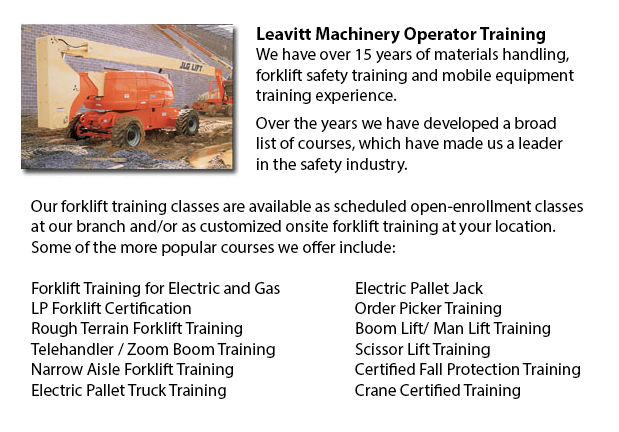
Manlift Training Glendale - Different manlift training programs include the content and review of manlift devices. An important portion of the program is the practicum where students show their practical ability and knowledge to safely operate a manlift. A requirement to Manlift training is the fall protection training, which may be incorporated in the training according to the specific requirements of the customer.
Course Content
The program content includes: pre-shift equipment inspection and work area survey requirements; the impact of doing unsafe acts or operating unsafe machines, Review of load capacities, Lifting devise machine definitions, safety decals and specific machine requirements, Review of related sections of the CSA Standards and the OHSA Standards and Review site specific Hazards, together with controls for safely utilizing a lifting device.
Demonstration and Evaluation Content
Evaluation and demonstration content comprises: Utilizing a spotter or a signaler when required; Proper personal protective equipment or P.P.E. as needed; Utilizing a lift just on solid and level ground; Making use of the right fitting harness or fall arrest device; Aware of load limits etc. and other specs set out by the manufacturer; Operating the lift with all other staff clear of the job location; Having all associated machine safely stored on the lift platform; Pre-shift work area survey and equipment inspection; Isolating off the work area when major work projects are to be carried out; and ensuring a safe and smooth operating speed for different plant conditions
Each of the trainees would undergo testing to make sure that they are able to safely operate their equipment.
Manlift Safety
As the manlift is capable of lifting materials and personnel more than 20 feet in the air, these machines pose a particular amount of risk and can be dangerous machines if not utilized correctly. Since the danger is so apparent, lift owners and operators are careful to correctly maintain their equipment and follow correct safety precautions and operating procedures. The ratio of accidents involving this specific apparatus is fairly low.
The safety specifications for boom lifts and scissor lifts puts the burden for safe manlift operation on the user. You are responsible for understanding how to safely operate the lift even if you only rent the machinery for one day. The most basic safety features on the machinery are the operating guidebook and safety decals. These show important information regarding the operating procedures, safety equipment and maintenance.
Newer lift models will come together with instruction manuals and decals in place. Technically, the operating guidebook must be kept on the lift itself. If you are buying a second-hand lift, it is essential to make sure that the manual is included and that important decals haven't been painted over. The restraints which prevent operators from falling and the guardrails are other vital safety features. These are mandatory and standard on all types of lifts.
-
Aerial Lift Train the Trainer Glendale
Aerial Lift Train the Trainer Glendale - The Aerial Lifts Train the Trainer Certification Program will teach trainers how to effectively train operators in safe industrial mobile machine operation. Trainers are given in-depth instruction on aerial li... More -
Forklift License Glendale
Forklift License Glendale - In North America, acquiring a forklift license or forklift certification involves hands-on and classroom training. Regulatory control over certification, training and license for powered industrial truck operators falls un... More -
Telehandler Certification Glendale
Telehandler Certification Glendale - Telehandler certification programs are both for operators who have some experience driving a typical forklift and for individuals with no experience. The real-world training provided by these courses produces grad... More -
Operator Safety Training and Re-Qualification Training and In-House Instructor Training in Glendale
Forklifts are used in almost all warehouse operations and in boat yards and in industrial construction sites. The reach feature of a forklift is a very important component utilized in a variety of applications like for example when a shelving system... More -
Crane Certification Glendale
Crane Certification Glendale - The Crane Certification Program consists of the industry suggested subject matter which will teach the safe and efficient operation of cranes. The individual would train in the following: how to identify cranes and thei... More -
Loader Ticket Glendale
Loader Ticket Glendale - Gehl articulated loaders have been made to suit practically every condition. They offer optimal maneuverability and great traction due to a heavy-duty oscillating joint that provides 45-degree rotating angles right and left,... More -
Crane Ticket Glendale
Crane Ticket Glendale - The new version of a crane could be either simple or complex, and cranes vary based on their use. Mobile cranes, for instance are rather simple. A telescopic boom or steel truss mounts its movable platform. A system of levers... More -
Forklift Instructor Training Glendale
Forklift Instructor Training Glendale - Forklift Instructor training certification is recommended for forklift operators who wish to become instructors. To qualify for forklift instructor training, operators must be able to prove they possess a high... More

Forklift Training Glendale
TOLL FREE: 1-888-254-6157
Glendale, Arizona
forkliftcertificationglendale.com
Email Us
About Us


